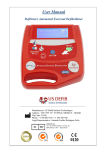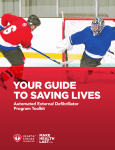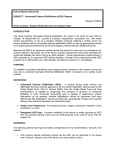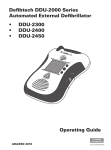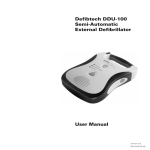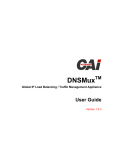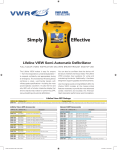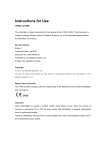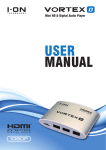Download Fairfield City Schools, Fairfield, Ohio Page 1 of 7 PROCEDURES
Transcript
File: EBBA -R-2 PROCEDURES FOR ADMINISTERING THE AUTOMATED EXTERNAL DEFIBRILLATOR (AED) PROGRAM Purpose The practices and procedures described in this document comprise the program through which the Board will administer its Automated External Defibrillator Program. This program will conform to standards set forth by the American Red Cross (ARC) and will follow the requirements of Ohio Revised Code, Section 3701.85. All personnel will follow this program. A copy of this program will be supplied to any employee upon request. This program will be reviewed as needed and updated whenever new or modified tasks or procedures are implemented. A copy of this program has been provided to the fire departments with jurisdiction within the boundaries of the District. Definitions Automatic External Defibrillator (AED) - a device used to treat a patient with cardiac arrest whose heart is beating irregularly (fibrillating) by assessing the patient's heart rhythm, judging whether defibrillation is needed, and then administering a shock to return the heart to normal. AED Medical Director - a designated, licensed physician providing medical oversight to the AED program, who is responsible for reviewing and approving emergency medical response procedures and a quality improvement plan. Core Emergency Response Team - the group of Trained Rescuers (including a school nurse) who provide basic life support (CPR and First Aid) and apply AED's during medical emergencies. School AED Coordinator - the person designated by the District who conducts the day-to-day duties associated with the AED program, serves as the Medical Director's point of contact for the AED program, and is the primary liaison between Trained Rescuers and the Medical Director. Sudden Cardiac Arrest (SCA) - a condition where the heart stops beating suddenly and unexpectedly, due to a disturbance in the heart's electrical system called ventricular fibrillation. Trained Rescuer - a person or category of people designated to respond to medical emergencies, and possess proper training in CPR, First Aid, and AED use within the confines of the AED program including defibrillation of the victim. Volunteer Responder - a person or category of people who provide voluntary assistance to victims of medical emergencies or who voluntarily assist members of the Core Emergency Response Team. Responsibilities A. Medical Director The Medical Director providing medical direction to this program is: Doctor to be assigned by Mercy Hospital Fairfield, Fairfield, Ohio, 513-870-7000 Fairfield City Schools, Fairfield, Ohio Page 1 of 7 File: EBBA -R-2 Medical direction will include the following: • • • • Write a prescription for AEDs. Provide medical direction for use of AEDs. Review and approve emergency procedures related to the use of AEDs and CPR within the District. Review and evaluate response documentation and rescue data for all uses of AEDs. B. School AED Coordinator The School AED Coordinator is: 1. The Support Services Director 2. Assisted by the District Athletic Trainer The School AED Coordinator is responsible for the following: • Serves as liaison between the District's AED program and the Medical Director, including communication with the Medical Director on issues related to the medical emergency response program and forwarding post event data for review. • Ensures selection of core emergency response team members, including a school nurse. • Communicates with school authorities about the AED program and core emergency response team members. • Ensures that the heads of emergency response teams organize all initial and refresher training programs. • Ensures that the heads of emergency response teams maintain all AED equipment, related supplies, and records. • Conducts post-incident debriefing sessions for any employees involved in AED use incidents. C. Core Emergency Response Team (Trained Rescuers) The AED may be used by: • All members of the school's Core Emergency Response Team who have successfully completed training • Any trained team member who has successfully completed an approved AED training program within the last two years and has a current successful completion card. The Core Emergency Response Team members (Trained Rescuers) must include a school nurse, who will serve as the head of the team. The building administrator shall name a person to be acting head of the team, should the school nurse be absent when the team is activated. The Core Emergency Response Team members’ names will be provided to the Support Services Director (School AED Coordinator). Responsibilities of the Core Emergency Response Team (Trained Rescuers): • Activating the internal emergency response system during medical emergencies and providing prompt basic life support including AED and first aid according to training and experience. Fairfield City Schools, Fairfield, Ohio Page 2 of 7 File: EBBA -R-2 • • • Understanding and complying with the requirements of this program. Following any additional procedures and guidelines for the Core Emergency Response Team. Activating community EMS. D. Volunteer Responder Responsibilities: • Anyone can, at their discretion, provide voluntary assistance to victims of medical emergencies. Such assistance may include providing CPR, providing medical first aid, activating the AED core emergency response team, and/or initiating contact with the community EMS. The extent to which these individuals respond shall be appropriate to their training and experience. E. Training Initial Training Core Emergency Response Team members (Trained Rescuers) Any employee identified as a Trained Rescuer who is expected to provide emergency care to a patient of SCA or other medical emergency will be trained in CPR and AED use. This training will conform to the American Red Cross (ARC) standards or standards of another nationally recognized training organization. Training will also include information on observing "Universal Precautions" against bloodborne pathogens when treating SCA and/or accident victims. Trained Rescuers are required to renew CPR and AED training every two (2) years. The school will maintain all training records. Volunteer Responders: These responders will possess various amounts of training in emergency medical response and their training may be supplied by sources outside the school district. Volunteer responders can assist in emergencies, but must only participate to the extent allowed by their training and experience. Volunteer responders wishing to potentially use one of the AEDs throughout the school district should have successfully completed an approved AED course within the last two years. The school will not maintain training records for volunteer responders. Refresher Training Core emergency response team members (trained rescuers) will renew CPR and AED training through approved training courses every two years. F. AED Location The AEDs are located as follows: • Senior High - 1 located in lobby of Performing Arts Center, 1 located outside lower level of Arena doors, 1 located in Athletic Trainer’s office that travels to athletic events, and 1 located outside clinic office • Freshman School -1 located outside clinic office • Middle School -1 located in gymnasium lobby, 1 located in a cabinet at the intersection of the 200 and 400 wing • Intermediate School –1 located outside clinic office • Central Elementary – 1 located outside clinic office Fairfield City Schools, Fairfield, Ohio Page 3 of 7 File: EBBA -R-2 • • • • • • • East Elementary – 1 located in lobby North Elementary – 1 located in lobby South Elementary – 1 located in lobby West Elementary – 1 located outside clinic office District Office- 1 located in mail room Transportation Building – 1 located in closet located near offices Support Services/Maintenance Building – 1 located in lobby Each AED will be equipped with one pair of electrodes both adult and child within expiration date, two pairs of non-latex gloves, razor, scissors, gauze pads, one facemask barrier device, and an incident report form. G. Indication for AED Use The AED should be used only on a patient who is: • Unconscious • Not breathing • Has no pulse The AED should be placed on any person who is at least eight (8) years of age or weighs a minimum of 55 pounds and displays ALL the above listed symptoms of cardiac arrest. An AED with pediatric pads can be used on any person older than one year of age and at least eight years of age or weighs less than 55 pounds. An AED should never be used on any person younger than one year of age. The AED should be used with caution if the victim has: • Nitroglycerin patch on chest (remove nitroglycerin patch carefully; then apply AED) • Implanted pacemaker (pacemaker may interfere with rhythm analysis; do not place electrodes directly over pacemaker). • Jewelry should be removed if possible. H. Responding to Emergencies A volunteer responder or Core Emergency Response Team member (Trained Rescuer) will notify the school office of the location and nature of a medical emergency. Personnel in the school office will notify all the school's Core Emergency Response Team members (Trainer Rescuers) of the nature of the medical emergency and direct them to the location of the emergency. In the event that the medical emergency is located outside of a school building, the volunteer responder or Trained Rescuer who discovers the emergency will notify other emergency team members via walkie talkie, cell phone, or through directing another person at the scene to personally communicate the location and the nature of the emergency to designated authorities. The AED and first aid emergency care kit will be brought to all medical emergencies. The following steps will be taken by the Trained Rescuers upon arrival at the location of the medical emergency: 1. Assess Scene Safety During emergency situations, Trained Rescuers must assess the scene for safety hazards. Some examples are: Fairfield City Schools, Fairfield, Ohio Page 4 of 7 File: EBBA -R-2 • • • • • • Electrical dangers (downed power lines, electrical cords, etc.; do not use a cell phone within 6 feet of the victim; move victim off conductive surface) Chemical (hazardous gases, liquids or solids, smoke, etc.) Harmful people (anyone that could potentially harm you) Traffic (make sure you are not in the path of traffic) Fire or flammable gases such as medical oxygen, cooking gas, etc. Weather (move victim out of the rain or from puddles of water) 2. Assess Unresponsiveness Verify that the victim is actually unconscious. Tap the victim on the shoulder and shout, "Are you OK?" 3. Activate the EMS system Dial 911. Have a designated person wait outside for EMS to arrive to lead emergency response personnel to the victim. (Note: Some phone systems require you to dial a "9" to access an outside line; in that case, dial 9-911.) 4. Use the pre-selected code over the PA system to have the AED brought to the scene, or send someone to get the AED, if the AED has not been brought to the medical emergency. In the meantime: 5. Check the victim for signs of life such as pulse (for children), breathing, or movement. If the victim shows no signs of life, perform CPR until the AED arrives at the scene. 6. Once the AED arrives: Check the area around the victim for safety, including the following: • Do not use an AED on a victim lying in contact with water. Move the victim away from puddles of water or out of the rain before defibrillating. • Do not use a cell phone or portable radio with in six (6) feet of an AED. The signals may interfere with the AED analysis. • Do not use an AED on a victim lying on a conductive surface. The AED should be placed on any person who is at least eight (8) years of age or weighs a minimum of 55 pounds and displays ALL the symptoms of cardiac arrest. The AED will be placed only after the following symptoms have been confirmed: the victim is unconscious, is not breathing, and has no pulse and/or shows no signs of life. The pediatric pads should be used on any person over one year of age and at least eight years of age or less than 55 pounds. Turn on the AED and follow all voice prompts. • Place electrodes (Note: For patients with large amounts of body hair, it may be necessary to shave areas prior to placement of electrodes. Body hair may interfere with the AED. The First Aid Kit includes disposable razors and shave cream. Do not use alcohol to wipe patient's chest. Alcohol is flammable.) • Stand clear of the victim and allow the AED to analyze. Fairfield City Schools, Fairfield, Ohio Page 5 of 7 File: EBBA -R-2 • If prompted by the AED, verify that the victim is clear and deliver shock. The Trained Rescuer will state "clear" and make a visual head-to-toe check of the victim, making sure that he/she and any other rescuers are "clear" of contact with the victim. Once this is accomplished, the Trained Rescuer will press the button to deliver a defibrillation pulse. If no shock is advised, the AED will prompt the Trained Rescuer to check pulse, and if absent, perform CPR. If a pulse or signs of life such as breathing and movement are present, check for normal breathing. If the victim (age 12 or younger) is not breathing, give rescue breaths and the AED will re-analyze. 7. When EMS arrives provide the following information: • • • • • Victim's name. Any known medical problems, allergies, or medical history. Time victim was found. Initial and current condition of the victim. Information from the AED screen (number of shocks delivered, length of time the defibrillator has been used). I. Medical Response Documentation Internal Post Event Documentation It is important to document each use of the core emergency response system. A member of the Core Emergency Response Team or the volunteer responder shall complete a medical event form whenever an AED is attached to a victim. These forms shall be maintained by the School AED Coordinator. External Post Event Documentation Medical emergencies involving the use of an AED require special documentation. Any and all patient information generated during AED use must be collected into the patient's confidential medical file. A copy of AED use information, a post event review summary, and all rescue data recorded by the AED must be provided to the Medical Director for review within 72 hours of the emergency. J. Post Event Review Following each deployment of the Core Emergency Response Team, or if a volunteer responder activates an AED, a review of the event shall be conducted to determine any deficient practices and opportunities for improvement. The School AED Coordinator will conduct the review, and all key participants in the events shall participate in the review. A summary of the post event review shall be included in the information sent to the Medical Director. The School AED Coordinator shall maintain a copy of the post event review summary. K. Basic Equipment Maintenance All equipment and accessories necessary for support of medical emergency response shall be maintained in a state of readiness. Specific maintenance requirements include: Fairfield City Schools, Fairfield, Ohio Page 6 of 7 File: EBBA -R-2 • • • • • The Head of the Core Emergency Response Team shall be responsible for restocking depleted AED supplies and checking the AED for damage after each AED use. The AED battery also must be checked prior to returning the AED to service. The Head of the Core Emergency Response Team shall be responsible for having regular equipment maintenance performed. Each AED unit should be inspected and tested regularly as per state, local, or manufacturer's guidelines. Refer to the User Manual for complete maintenance schedule and tasks. Implement this schedule and tasks as recommended in the User Manual. Following use of emergency response equipment, all equipment shall be cleaned and/or decontaminated as required. If contamination includes body fluids, the equipment shall be disinfected according to OSHA Bloodborne Pathogen Standards. Each AED unit shall be maintained with all necessary supplies, including one pair of electrodes both adult and child within expiration date, two pairs of non-latex gloves, razor, scissors, gauze pads, one facemask barrier device, and an incident report form. The Head of the Core Emergency Response Team shall be responsible for maintaining records of equipment maintenance. Maintenance check will be held in January, June, and August. L. System Verification and Review The core emergency response team is ultimately successful if necessary medical equipment is provided to victims in a timely and safe manner. Since actual use of this system procedure is expected to be infrequent, other measures of effectiveness are required. Monthly System Check Once each calendar month, the Head of the Emergency Response Team shall conduct and document a system check. This check shall include review of the following elements: • Emergency kit supplies • AED battery life • AED operation and status Annual System Assessment Once each calendar year, the School AED Coordinator or designee shall conduct and document a system readiness review. The review shall include review of the following elements: • Training records • Equipment operation and maintenance records. Note: Contracted and other community activities are not guaranteed access to an AED as part of the standard rental contract. (Issue date: November 15, 2006; Revised: June 16, 2011) Fairfield City Schools, Fairfield, Ohio Page 7 of 7








